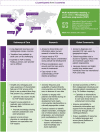Current challenges and opportunities in the care of patients with fibrodysplasia ossificans progressiva (FOP): an international, multi-stakeholder perspective
- PMID: 35436894
- PMCID: PMC9014788
- DOI: 10.1186/s13023-022-02224-w
Current challenges and opportunities in the care of patients with fibrodysplasia ossificans progressiva (FOP): an international, multi-stakeholder perspective
Abstract
Background: Fibrodysplasia ossificans progressiva (FOP) is an ultra-rare, disabling genetic disorder characterized by congenital malformations of the great toes and progressive heterotopic ossification of soft and connective tissues. Assiduous attention to the unmet needs of this patient community is crucial to prevent potential iatrogenic harm and optimize care for individuals with FOP.
Objective: To gather international expert opinion and real-world experience on the key challenges for individuals with FOP and their families, highlight critical gaps in care, communication, and research, and provide recommendations for improvement.
Methods: An international group of expert clinicians, patients and patient advocates, caregivers and representatives from the international FOP community participated in a virtual, half-day meeting on 22 March 2021 to discuss the key unmet needs of individuals with FOP.
Results: Individuals with FOP often face the frustration of long diagnostic journeys, the burden of self-advocacy and the navigation of novel care pathways. Globally, patients with FOP are also confronted with inequities in access to diagnosis and specialist care, and consequently, unequal access to registries, clinical trials, and essential support from patient associations. Organizations such as the International FOP Association, the International Clinical Council on FOP, and national FOP organizations work to provide information, facilitate access to expert clinical guidance, nurture patient empowerment, fund FOP research and/or foster meaningful collaborations with the research community. The non-profit Tin Soldiers Global FOP Patient Search program aims to identify and provide a pathway to diagnosis and care for individuals with FOP, particularly in underserved communities. Such global initiatives and the increasingly widespread use of telemedicine and digital platforms offer opportunities to improve vital access to care and research.
Conclusions: This multi-stakeholder perspective highlights some of the unmet needs of individuals with FOP and their families. Regional and international organizations play an important role in improving the quality of life of those they reach in the global FOP community. However, globally, fundamental issues remain around raising awareness of FOP among healthcare professionals, identifying individuals with FOP, reducing time to diagnosis, and ensuring access to best practice in care, support, and clinical research. Medical writing support was industry-sponsored.
Keywords: Diagnosis; FOP; Fibrodysplasia ossificans progressiva; Health policy; Patient care; Rare disease; Unmet needs.
© 2022. The Author(s).
Conflict of interest statement
RJP: Research investigator: Clementia/Ipsen, Regeneron; Advisory board: President of the International Clinical Council (ICC) on FOP; CBG: IFOPA Board Member, IFOPA Executive Committee Member, FOP Friends Chair and Trustee, International President’s Council Chair; AC: Trustee of the Radiant Hope Foundation, Trustee of the Ian Cali FOP Research Fund/Penn Medicine, Co-founder and Advisory Board member of the Tin Soldiers Patient Identification Program, Executive Producer of the Tin Soldiers documentary, Past IFOPA Chairman of the Board, Executive Associate of the International Clinical Council (ICC) on FOP; MD: Member of the Rare Bone Disease Alliance Steering Committee and the Global Genes RARE Global Advocacy Leadership Council; PLRD: Research investigator: Clementia/Ipsen; Member of the International Clinical Council on FOP; MR: Fundación FOP Board Member, IFOPA member; CS: Vice Chairman of the Board, Board member of Tin Soldiers Patient Identification Program, Member of the International Clinical Council (ICC) on FOP, Member of the IFOPA Medical Advisory Board, Tin Soldiers Board Member, Member of the International President’s Council; KG, CH, AK, HN: No competing interests to declare; FSK: Research investigator: Clementia/Ipsen, Regeneron; Advisory Board: IFOPA Medical Advisory Board; Founder and Past-President of the International Clinical Council (ICC) on FOP; Chair of the Publications Committee of the ICC. In April 2019, Ipsen acquired Clementia Pharmaceuticals.
Figures


References
-
- Liljesthröm M, Pignolo R, Kaplan F. Epidemiology of the global fibrodysplasia ossificans progressiva (FOP) community. J Rare Dis Res Treat. 2020;5(2):31–36. doi: 10.29245/2572-9411/2020/2.1196. - DOI
Publication types
MeSH terms
LinkOut - more resources
Full Text Sources

